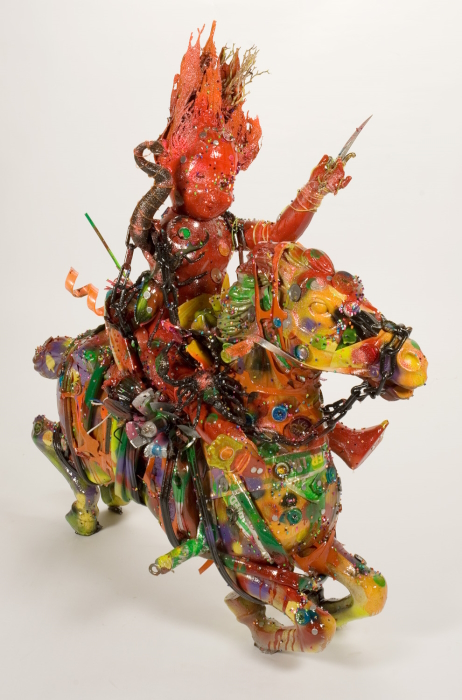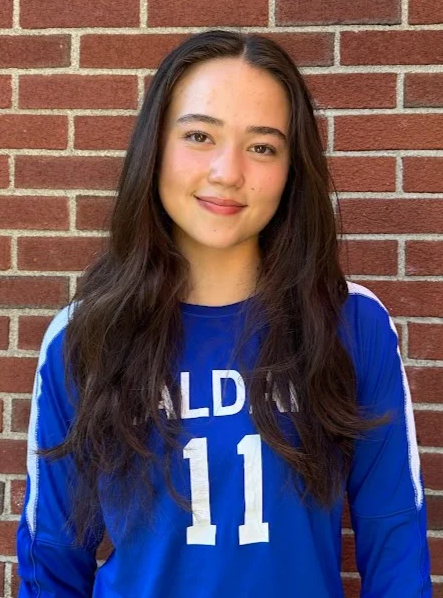Each year, the members of Ashley Linda’s journalism class at Haldane High School publish a newspaper, The Blue Print. With support from the Haldane School Foundation, The Current is working with the students to share their reporting with the community. Selections from the two most recent issues appear below.
Faculty Advisor: Ms. Linda
Senior Editor: Eloise Pearsall
Reporters: William Busselle, Anotonio Cardoso, Julian Constantine, Henry Foley-Hedlund, Shep Macinnes, Milla Maxwell, Corinna Mueller, Kayla Ruggiero, Dashiell Santelmann, Ivan Sicilliano, Ty Villella, Lincoln Wayland
“Ask Lisa” About Teen Mental Health
By Eloise Pearsall
Having good mental health doesn’t equal happiness, according to Lisa Damour, the mother of two daughters, the author of three New York Times bestsellers on teen mental health and the co-host of the Ask Lisa podcast, where she discusses how to recognize emotions and challenges in teenagers’ lives.

Damour, a senior advisor to the Schubert Center for Child Studies at Case Western Reserve University, also speaks to schools, professional organizations and corporate groups around the world. She recently spoke in Cold Spring about her book, The Emotional Lives of Teenagers.
“Teenagers have huge feelings,” she said. When assessing mental health in teenagers, an important question to ask is, does the feeling make sense in context?
Damour states that it is normal for teenagers to feel extreme emotions, and they should. When a teenager expresses “big” emotions, parents should take a deep breath: This is one sign, of many, that their teen has good mental health. In fact, Damour talks about how adults should be worried if their teen isn’t expressing big emotions.
“Stress is OK only when paired with adequate restoration,” she said. Damour compares this to strength training in the gym. Working hard in the gym only works when one pairs it with adequate rest; those who do not take rest days burn out.
For parents and teachers, being a “steady presence” is of utmost importance when it comes to a teenager’s distress and holding the space for them to build tolerance to distress is being a steady presence. A parent’s ability to tolerate stress in their children is “the thing that builds their ability to tolerate distress in themselves,” Damour emphasized.
In addition to their family, teenagers spend a lot of time with their teachers. For the past two years, teachers at Haldane have participated in book talks as a way to look at their teaching practice through a science-based lens.
Last year, they read Stolen Focus: Why You Can’t Pay Attention, by Johann Hari, which informed a new policy requiring students to store their phones during class.
Rep. Lawler Visits Haldane
By Will Busselle and Eloise Pearsall

On Feb. 26, Rep. Mike Lawler visited Haldane High School.
During lunch, juniors and seniors packed Room 211. Lawler, wearing a blue suit and holding a large Dunkin’ Donuts cup, began his visit by talking about how he first got involved in politics by interning for John McCain’s presidential campaign. He took a broad range of questions from students, including some tough questions about his stances on divisive issues such as abortion, immigration and wars overseas.
“He was a very confident person talking to a group of teenagers,” said senior Bella Tomizawa, who noted that many students can be opinionated and stubborn.
Lawler answered fewer questions than expected and did not leave room for much discussion during his 35-minute visit. “He kind of did not answer peoples’ questions,” said Tomizawa. “They wanted a straight answer.”
Lawler has been making many public appearances in the district to connect with constituents, including on Feb. 9 at Philipstown Town Hall.
Many Haldane students will be able to vote for the first time in the 2024 election, in which Lawler will be running for reelection. Public appearances like these could give voters more certainty on who they will vote for.
When discussing Lawler’s visit, we noticed that many students were not well-informed about political issues.
Identity Interlocutor
By Julian Costantine
At first glance, we may view people or sets of people as scarcely accurate stereotypes. Some artists believe that it is their responsibility to challenge these.
Maxwell Cloe, a 26-year-old queer artist from the Appalachian Mountain region, is looking to change people’s perspective. He spoke recently to the Haldane Identity Club about his research and work.

Cloe grew up and lives in Richmond, Virginia. He said his work began as a way to challenge the misconceptions that most people have about this region of the U.S. He helps promote work by artists from Appalachia, such as Bob Morgan, Julie Rae Powers, Liz Williams, Mo Kessler and Megan King, on his website (maxwellcloe.com) and social media. Their art centers on themes such as U.S. history, colonialism, queerness and Indigenous people.
Kiera Shanahan, a junior at Haldane, invited Cloe to speak to the Identity Club. They are cousins, so the connection was easy to make.
Much of the art shown on Cloe’s website is made with everyday objects. In “God Willing and the Creek Don’t Rise,” Kessler uses yarn to connect two trees and a gazebo. Morgan creates sculptures, such as “Fires of Pangea,” from buttons, toys, dolls and paint.
Would You Give Up TikTok?
By Eloise Pearsall
I gave up TikTok for a week and became aware of how it impacts my everyday life.
Whether it’s the newest news, concert tours or college advice, TikTok’s algorithm knows what you and I like watching the most. TikTok fills half my daily screen time. Oftentimes, I scroll mindlessly through what must be hundreds of short videos, wasting valuable time I could be using to do something productive.
 “I try not to open it, because as soon as I do, I know I’m going to be on there for so much longer than I want to be,” said senior Percy Parker. “I feel like I’m getting less smart the more time I spend on it because it’s killing my attention span.”
“I try not to open it, because as soon as I do, I know I’m going to be on there for so much longer than I want to be,” said senior Percy Parker. “I feel like I’m getting less smart the more time I spend on it because it’s killing my attention span.”
When I had the thought of deleting the app for just a week, I was worried about not being able to talk about things with my friends. The fear of missing out is pretty daunting. But I realized that few conversations were actually centered around niche online content but on daily life outside social media.
Senior William Busselle offered reassurance. “I don’t know the dances, but I don’t feel like I’m missing out on much.”
During my first two days without TikTok, I found loopholes such as Instagram Reels. I was not alone. Wilson Robohm, a junior, said he tried to limit his TikTok time to an hour a day but “that just made me switch to Instagram Reels, which I’m on for like 2½ hours a day.” Another senior, Quin Carmicino, said she deleted TikTok but still uses Instagram Reels.
By the end of the week without TikTok, my screen time was down 36 percent. I am noticing that I use TikTok far less. Knowing that I could go through my day without feeling excluded from online content gave me the reassurance I needed to disconnect.
An Assignment to Use ChatGPT
By Lincoln Wayland
With AI generators like ChatGPT, cheating has never been easier, especially for English: Type in whatever prompt your teacher gives you and it’ll give you a great (or, at least, middling) essay.
Earlier this year, Mrs. Martinez gave an unusual assignment to her senior honors class: Students were allowed to write an essay using ChatGPT.
After attending a regional conference about AI and its effects and applications in education, Mrs. Martinez said she wanted to address the question: How much will AI help students?
She assigned an essay on the Barbie movie, which ChatGPT is likely not yet trained on, meaning students would have to tell the language model about the plot.
“I wanted them to see the limitations of the chatbots, and I wanted them to learn how to craft a prompt, which helps with thesis development, and see how AI can be used as an editing helper,” Mrs. Martinez said.
While grading the essays, she said she found students did better the less they relied on ChatGPT. With AI assistance, “the grammar was correct, but the content wasn’t quite as good,” she said.
Some students expressed frustration with AI’s limitations. For instance, it was hard to get ChatGPT to give them 1,000 words in one go.
5 Questions: Scotia Hartford
By Milla Maxwell

What’s a school dance without its music? I reached out to Scotia Hartford, one of the juniors who worked on the music playlist for the winter dance.
Who asked for the playlist?
Mrs. Granese and Mrs. Peparo and some fellow Student Council members. I was originally just there to help start the playlist but I got engulfed by the whole task. I am not complaining, though, it was a lot of fun.
How do you choose the songs?
We added our favorites and reached out for recommendations. We kept in mind some “classic” dance songs from previous dances. Our goal was to curate a wide playlist that most people would like or have fun dancing to.
How long did it take?
We did most of it during a Student Council meeting during lunch. We added songs along the way until a couple of days before the dance. Mrs. Granese and Mrs. Peparo only required that the playlist last at least four hours and was clean [non-explicit].
Did you get any input from other students?
We got a fair amount of input from other students, but it was ultimately our decision whether to add a song, so we filtered out many requests.
What is your favorite song or favorite artist?
This is such a tough question. I am a big fan of Drake, Brent Faiyaz and Kendrick Lamar. I’ve been playing “Dark Days,” by 21 Savage and Mariah the Scientist, on repeat.


